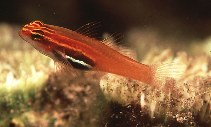| Family: |
Gobiidae (Gobies), subfamily: Gobiinae |
| Max. size: |
1.71 cm SL (male/unsexed) |
| Environment: |
reef-associated; marine; depth range 3 - 20 m |
| Distribution: |
Pacific Ocean: Japan (southern Ryukyu Islands), Thailand, Brunei, Malaysia, Philippines, Palau, Indonesia (NW Kalimantan and Bali eastwards), Papua New Guinea, Solomon Islands, south to Australia (Great Barrier Reef) and east to New Caledonia. |
| Diagnosis: |
Dorsal spines (total): 7-7; Dorsal soft rays (total): 8-9; Anal spines: 1-1; Anal soft rays: 7-8. This species is distinguished from its congeners by the following set of characters: abdomen with black peritoneum, clearly visible externally; dorsal/anal formula 8/7; simple pectoral-fin rays; length of 5th pelvic-fin ray 40% or greater of 4th ray; genital papilla in male not fimbriate; cephalic sensory-pore system pattern group 2 (only IT missing) (Ref. 89418); characterized further by translucent red with pair of bright yellow stripe behind eye, lower stripe reaching midbody and upper nearly to caudal fin base; fins unmarked; longitudinal scale series 23-24; ctenoid scales, absent on head, nape and pectoral fin base; separated pelvic fins, thin membrane joining bases; 3-5 branches on fourth pelvic ray; depth of body 3.6-4.0 in SL (Ref. 90102). |
| Biology: |
Lives in small groups near Acropora colonies where it hides when threatened. Feeds on plankton(Ref. 89963). Sometimes solitary, frequently in shady spots near corals (Ref 90102). |
| IUCN Red List Status: |
Least Concern (LC); Date assessed: 06 March 2015 Ref. (130435)
|
| Threat to humans: |
harmless |
Source and more info: www.fishbase.org. For personal, classroom, and other internal use only. Not for publication.

